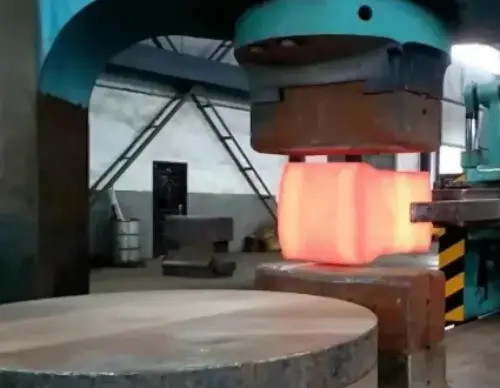In high-end equipment manufacturing, titanium castings, thanks to their high specific strength (twice that of steel), excellent corrosion resistance (over 20 years in seawater environments), and outstanding biocompatibility, have become the material of choice for core components such as aircraft engine compressor discs, deep-sea probe housings, and orthopedic implants. However, quality control of titanium castings throughout their lifecycle involves complex materials science and non-destructive testing techniques. This article will systematically analyze these issues from two perspectives: material selection strategies and testing methods.

I. Material Selection for Titanium Castings: Precision Matching Based on Application Scenario
The diverse composition and crystal structure of titanium alloys determine their differentiated performance characteristics. Material selection must adhere to the three principles of "environmental compatibility, performance balance, and process feasibility."
1. Titanium Alloy Type Selection: Integrated Structural-Functional Design
α-Type Titanium Alloys (e.g., TA2 Industrial Pure Titanium)
Core Characteristics: Excellent ductility (elongation ≥ 25%), good low-temperature toughness, and resistance to seawater corrosion. By forming a stable TiO₂ passivation film, it effectively resists pitting corrosion in 3.5% NaCl solutions.
Typical applications: Ship propellers, chemical heat exchangers, and desalination equipment.
α+β titanium alloy (e.g., TC4/Ti-6Al-4V)
Core characteristics: High strength (UTS ≥ 900 MPa), long fatigue life (10⁷ cycles without cracks), and sensitive heat treatment response. Its α+β dual-phase structure allows for dynamic control of strength and toughness through heat treatment.
Typical applications: Aero-engine blades, orthopedic joint implants, and racing connecting rods.
β titanium alloy (e.g., Ti-6242/Ti-6Al-2Sn-4Zr-2Mo)
Core characteristics: High strength and toughness (KIC ≥ 60 MPa·m¹/²), excellent thermal stability (strength retention ≥ 85% at 550°C), and 8% lower density than TC4. Its β-phase matrix achieves an ultrafine grain structure through solid solution strengthening.
Typical applications: Rocket fuel tanks, hypersonic vehicle hot-end components, and high-end bicycle frames.
Material selection logic: Dynamic load scenarios (e.g., aircraft engines): TC4 alloy achieves the optimal strength-toughness balance through solution treatment + aging (STA).
Extreme corrosive environments (e.g., deep-sea exploration): TA2 alloy exhibits a corrosion rate of only 0.002 mm/yr after five years of immersion in simulated seawater.
Lightweight requirements (e.g., satellite structural components): β-type titanium alloys maintain a UTS of ≥1100 MPa while increasing density by only 30% compared to aluminum alloys.
2. Purity Control: The "Threshold Effect" of Impurity Elements
Interstitial elements such as Fe, C, and N in titanium castings can cause performance degradation:
Fe content > 0.3% causes coarsening of the β-phase grains, reducing the fracture toughness of TC4 alloy from 65 MPa·m¹/² to 40 MPa·m¹/²;
O content > 0.2% forms a hard and brittle α-phase layer, increasing the surface crack rate during cold working to 15%;
H content > 0.015% causes hydrogen embrittlement, increasing the standard deviation of tensile strength from ±8 MPa to ±20 MPa.
Control measures:
Using an electron beam cooled hearth furnace (EBCHM), melting to evaporate low-boiling-point impurities (such as Mg and Ca) at a high temperature of 10⁴°C;
Performing three vacuum consumable arc melting (VAR) cycles to reduce the total oxygen content from 0.15% to below 0.08%;
Adding 0.1% Y (yttrium) to form Y₂O₃ particles that pin grain boundaries and inhibit oxygen segregation.
3. Material Optimization Driven by Product Requirements
For near-net-shape requirements, TC4-DT (damage-tolerant) alloy is selected. Refining the α-phase interlayer spacing (≤1μm) increases crack propagation resistance by a factor of two.
For welded structural parts, TA15 (Ti-6Al-2Zr-1Mo-1V) alloy is used. Its moderate β-stabilizing element content (Mo equivalent = 2.5) prevents martensitic transformation embrittlement in the weld zone.
For high-temperature creep scenarios: Adding 0.3% Si to Ti-6242 alloy forms silicide precipitation, reducing the creep rate at 600°C/100h by 60%.
II. Titanium Casting Inspection: Accurate Identification of Multi-Scale Defects
Titanium casting defects can be categorized into surface defects (cracks, cold shuts, oxide scale), near-surface defects (pores, porosity), and internal defects (shrinkage, inclusions). A tiered inspection strategy is required.
1. Macroscopic Appearance Inspection
Inspection Process:
① Visual Inspection (5x Magnification) → ② Fluorescent Penetrant Inspection (Color Intensity ≥ Level 4) → ③ Dimensional Measurement (CMM Coordinate Measuring Accuracy ±0.01mm).
Key Specifications: Surface Roughness Ra ≤ 1.6μm, Cold Shut Depth ≤ 0.2mm, Oxide Scale Thickness ≤ 0.05mm.
2. Nondestructive Testing for Internal Defects
X-ray Inspection:
Utilizing a 450kV microfocus X-ray source with a spatial resolution of 5μm, it can detect pores ≥ 0.1mm in diameter. In aircraft engine blade inspection, the defect detection rate reaches 99.7%.
Ultrasonic Inspection:
Using a 10MHz focused probe, TOFD (Time of Flight Diffraction) technology enables quantitative crack depth measurement with an error of ≤0.5mm. Suitable for rapid screening of castings with a thickness of 20-100mm.
Magnetic Particle Testing:
For surface cracks caused by ferromagnetic impurities (such as Fe particles), the AC yoke method (magnetic field strength ≥ 3 kA/m) is used, with sensitivity reaching Class A1 (0.01 mm artificial defects).
3. Microstructure and Property Testing
Metallographic Analysis:
The α/β phase ratio and grain size are observed through electrolytic polishing and oxalic acid etching. The ideal microstructure of TC4 alloy is 50% equiaxed α phase + 50% transformed β phase, with a grain size of ASTM grade 8-10.
Mechanical Property Testing:
The tensile test (GB/T 228.1) must meet UTS ≥ 895 MPa and elongation ≥ 10%; the impact test (KV₂) must meet absorbed energy ≥ 27 J at -40°C.
Corrosion Performance Evaluation: Potentiodynamic polarization testing is performed using a 3.5% NaCl solution at a flow rate of 0.1 m/s. The pitting potential of TC4 alloy must be greater than or equal to 500 mV (vs SCE).
III. Cutting-Edge Technology Trends
1. AI-Driven Defect Identification: An X-ray image analysis system based on a convolutional neural network (CNN) can complete defect classification in 0.2 seconds with an accuracy rate of 98.3%.
2. Additive Manufacturing Titanium Casting Inspection: Terahertz wave detection technology has been developed to detect incomplete fusion defects generated by the selective laser melting (SLM) process, with a penetration depth of up to 5mm.
3. Digital Twin Quality Traceability:
By modeling sensor data from the entire melting, casting, and heat treatment process, predictive maintenance of titanium casting performance is achieved, resulting in a reduction of the scrap rate from 5% to 0.8%.
Titanium casting quality control lies at the intersection of materials science, nondestructive testing, and intelligent manufacturing. From the precise selection of α-type to β-type titanium alloys, to multimodal inspection using X-ray, ultrasonic, and magnetic powder, to AI-enabled intelligent quality inspection, each technological breakthrough is driving the evolution of high-end equipment towards lighter, stronger, and more reliable features. In the future, with the integration of titanium alloy 3D printing and in-situ detection technology, the application boundaries of titanium castings will continue to expand.











